Prey Review
Me and Yu and a tool named GLOO
Prey is a completely different game from the one that released in 2006 with the same name. Unlike that older game, it has no bizarre gravity shifts, upside-down walkways, portals, spirit walks, or Native American themes. It's a new universe with new rules, and apart from the science-fiction setting and first person shooting, the two games are barely comparable. Which begs the question, why even use the same name at all? Prey has far more in common with System Shock from the now defunct Looking Glass Studios, but it also shares themes and gameplay mechanics with the BioShock and Deus Ex franchises. Those games allowed players to approach situations in several ways and encouraged preparedness. Prey is the same, you can sneak, shoot, hack, climb, explore, befriend, or murder when completing tasks on a large space station. It is an excellent game because it makes players an active participant in its hostile world. Prey allows, and adapts, to many choices, although minor flaws keep it from reaching the dizzying heights of its action RPG cousins.
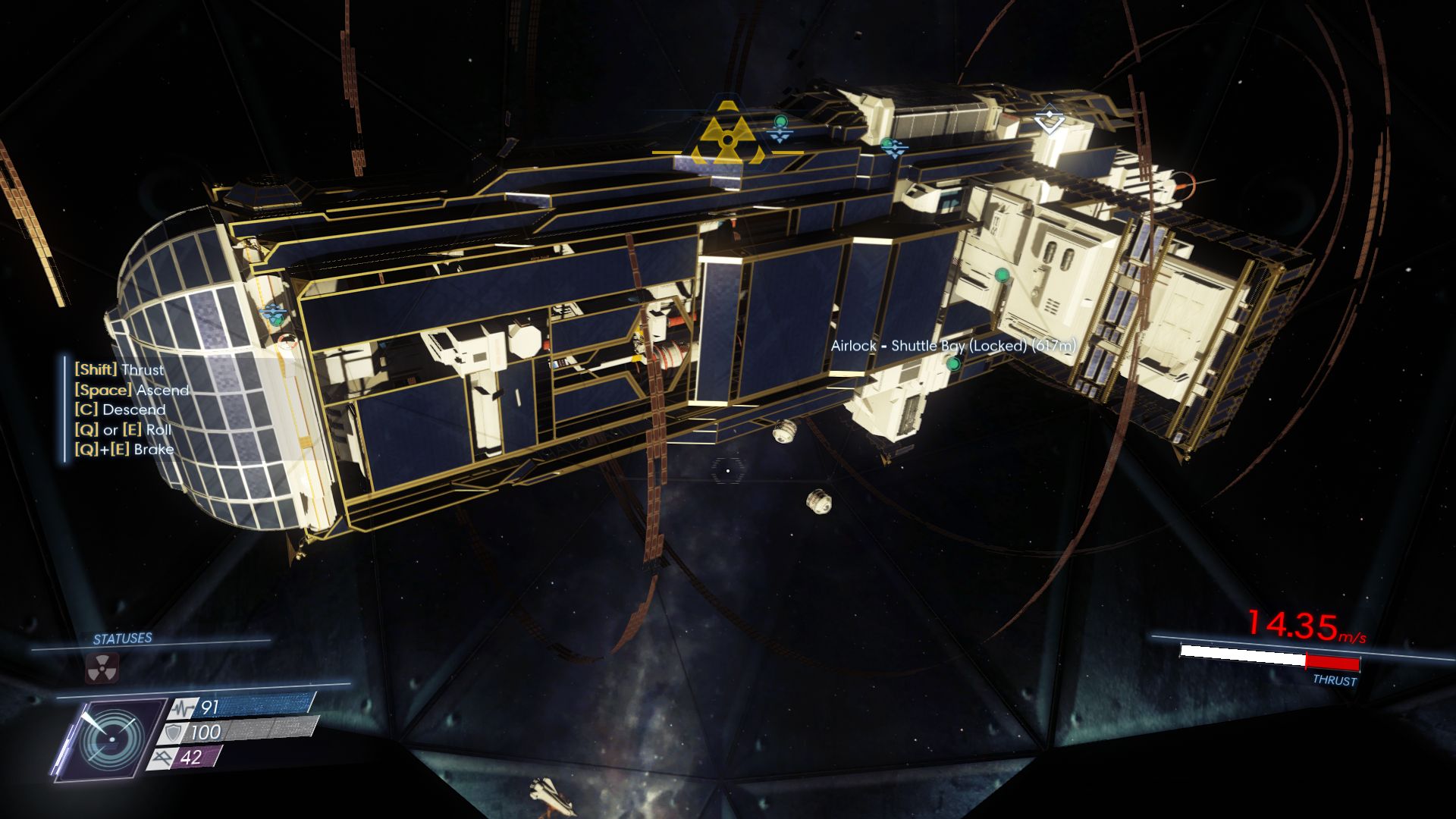
You will come to know the space station like the back of your hand
Prey takes place in an alternate version of the near future, on the massive Talos-1 space station that orbits the Moon. The half-mile long station is being used by TranStar Corporation to research a dangerous alien species, called Typhon, which have supernatural abilities. As so often is the case, we get to use 'gone too far' and 'science' in the same sentence. The Typhon creatures escape their confines and you arise amidst the chaos.
Actually you awake, as Morgan Yu, inside a simulation just before the aliens begin to kill everybody. Although Morgan is a leader at TranStar, he is a guinea pig for alien Neuromods because they are going to change humanity. Neuromods grant users enhanced talents by copying a skill from another mind. Now TranStar wants to access the supernatural abilities of the Typhon, although an early side effect is memory loss. Oh yes, Prey starts with a classic case of amnesia; a cliché of near equal standard is reserved for the finale. Soon you are guided by a robot voiced by Morgan, programmed by Morgan, created in the event that something went wrong. This hovering bucket of bolts wants to destroy the station while your surviving brother wants to preserve the research. Who can you trust? Who were you before you lost your memory? And who are you now?
The Talos-1 space station consists of around 12 modules connected together in a non linear fashion. Getting from the Power Plant, at the base of the facility, to the earth-like Arboretum, found at the top, may be a slightly confusing and lengthy trip. If the external airlocks are open, it is possible float to most modules directly via open space, although the exterior is cluttered and navigating with full six-degrees of freedom can be slightly nauseating. The Talos-1 layout is fine, and there are plenty of hidden or locked rooms to access when revisiting areas. It is great that all modules are completely open to explore for almost the entire game, apart from a few annoying hours in the first half when a weak story event demanded linear progress.
Typhon aliens are spread throughout the station. The most common are the headcrab-like mimics that can disguise themselves as small objects such as a health pack, lamp, or chair. Their constant presence creates hesitation when exploring areas and the occasional jump scare, although their particular camouflage gimmick gets old. Other Typhon include the humanoid Phantoms that can teleport short distances, invisible Poltergeists that hurl objects, and cacodemon-like Telepaths that can control the minds of the few remaining humans. Aliens repopulate modules after completing quests, so clearing areas is only temporary. There is enough variety and danger that dealing with these aliens will require some planning and/or effective weaponry.
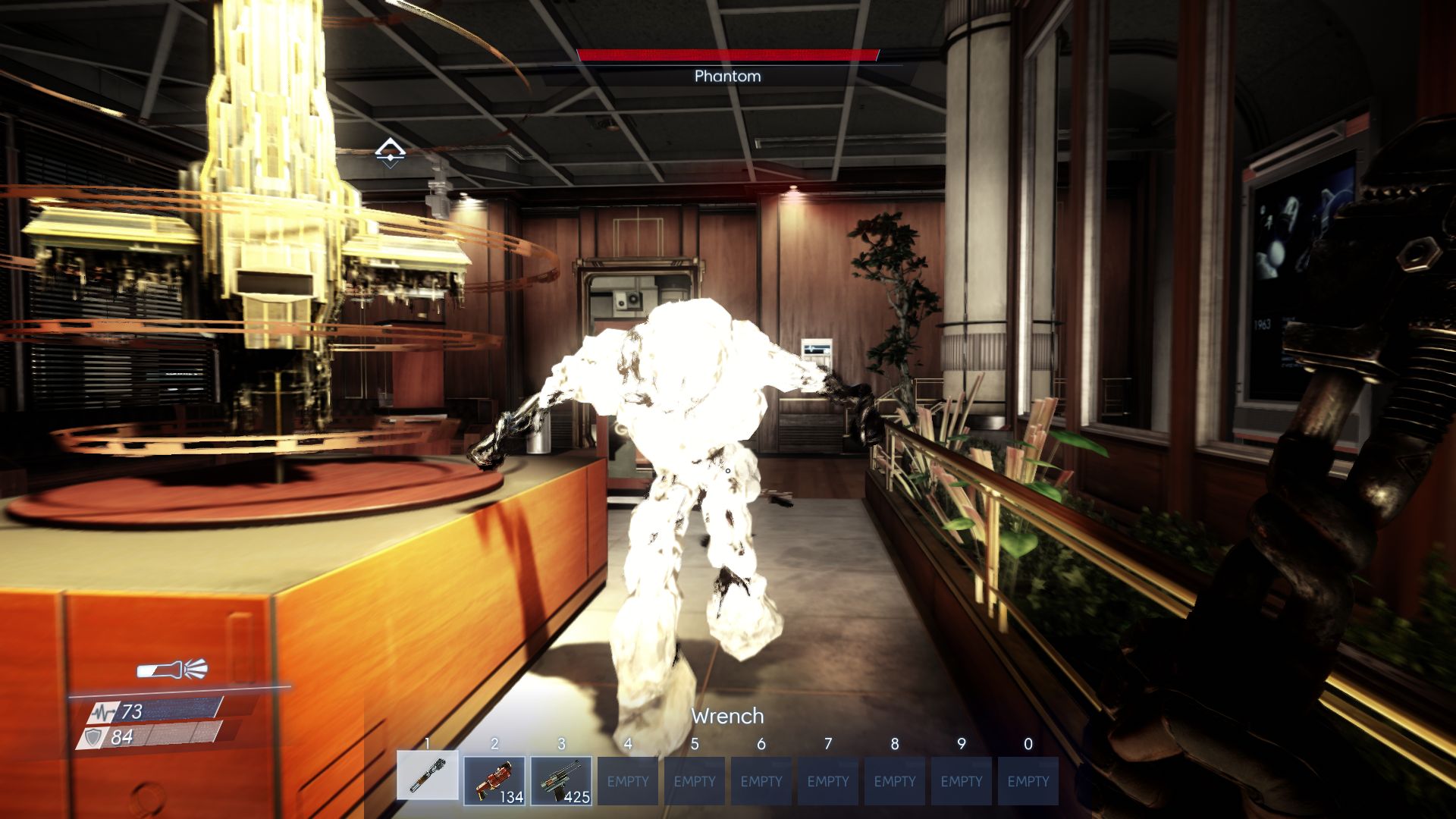
Who would have known that foam could be so useful?
The GLOO Cannon is one of the earliest tools acquired and it remains useful for the entire game. It is used for navigation, combat, and environmental protection. It shoots globs of foam material that will quench fires and temporarily halt electric sparks, quite useful on a station under constant peril. In combat, the organic material will slow and eventually halt most enemies, so they can be precisely attacked with other weapons, like the wrench—a classic one-two punch. But the GLOO Cannon's most interesting function is used for navigation. The globs can be climbed on, so any wall can become a ladder. That means you can get into the ceiling, or ascend an unpowered elevator shaft. Unfortunately climbing on the globs is clumsy because they do not extend far from the wall. Despite a few generally harmless falls, the GLOO Cannon is an excellent tool.
Other weapons are more traditional but all have a valid role. A stealth pistol provides a fairly consistent offensive output and the shotgun can take down a mimic in one shot when upgraded. A toy crossbow is terrible for combat, but its darts can hit buttons on computer screens from range, open door locks, and possibly distract. The experimental Q-Beam weapon will cause enemies to explode when they take enough damage. While the arsenal isn't extensive, all weapons are useful from start to finish. In most combat scenarios, either against robots or aliens, stunning or disabling enemies is heavily encouraged. Approaching hostiles without weakening them first is a good way to waste ammo or die.
Crafting ammo and other resources is essential for combat. While a lot of ammo can be found, some may need to be created with the awesome Fabricator devices found across the station. But first you need the appropriate resources, usually produced by the similarly awesome Recycler. All items will break down into four different resources, used to craft things like health, ammo, grenades, or weapons. One deadly grenade doubles as a recycler, so it can be used on enemies, or dropped inside a storage room crammed full of boxes for extra resources. The deconstruction and creation of items is a fantastic part of the game, managed by a near perfect grid-based inventory system. Unfortunately the Fabricator only makes one item at a time, so restocking after lengthy combat gets more tedious as the game progresses. One resource was always limited, forcing stealth and avoidance towards the end, as revisiting areas generally meant fewer resources to be found.
Thankfully you have access to Neuromod abilities to make the combat a little easier. Neuromods can be found or crafted and are used to unlock skills. There are two skill groups: Human and Typhon. On the Human side, most enhancements are fairly boring increases to passive stats like weapon proficiency, base health, stamina regeneration, or hacking ability. Speaking of hacking, the mini game associated with breaching electronic systems is rather bad and it is a shame there is no complementary hack tool. Combat Focus is one of the few cool Human abilities, and it's basically bullet time. While the Human skills are useful, they are rarely exciting.
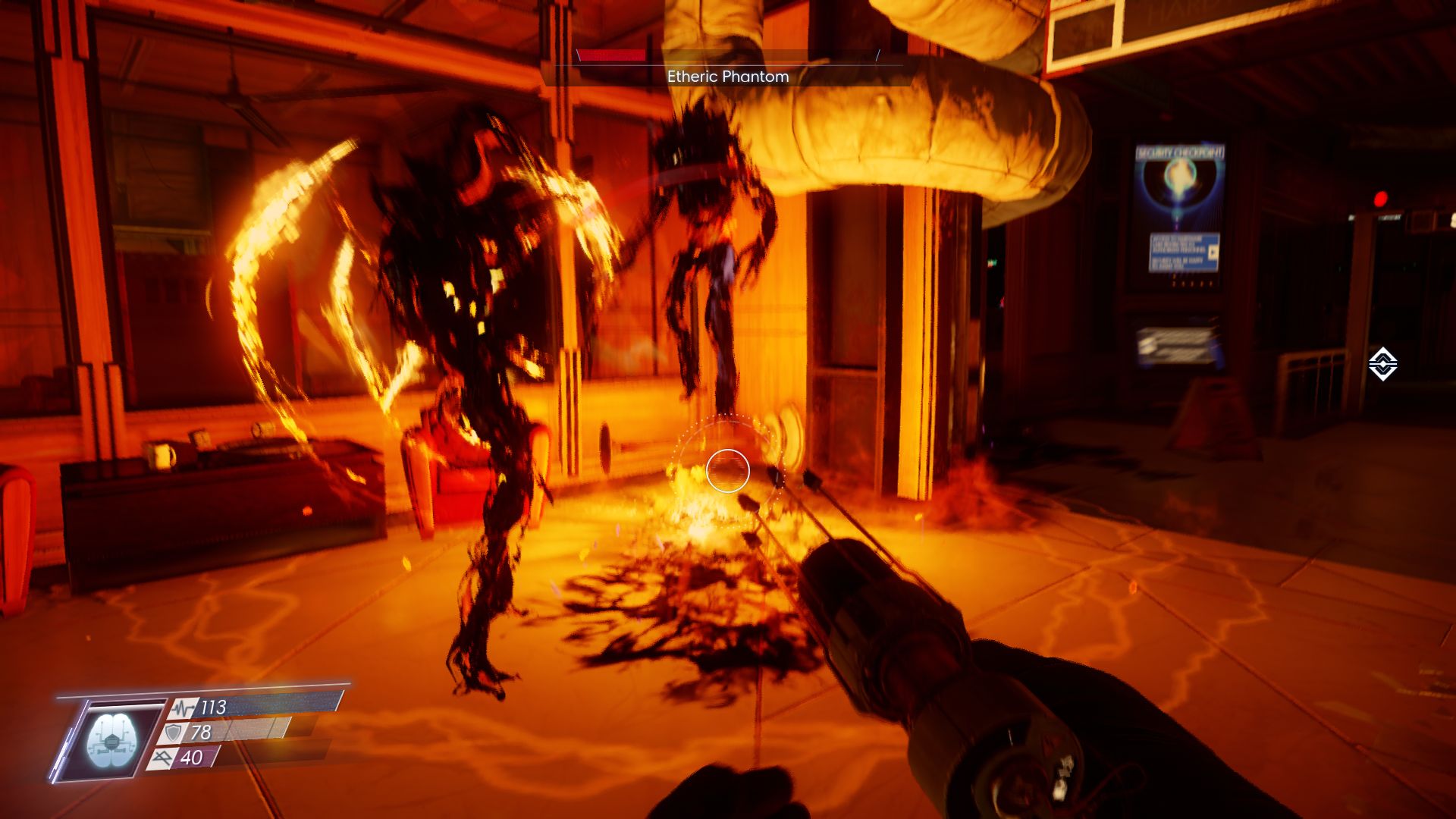
Unlock alien Neuromods to create your own Phantom army
Although discouraged by the narrative and characters, the Typhon Neuromods are far more appealing. Unlike the human skills, they must be unlocked by clumsily scanning each alien type. It is worth it though. You can use human corpses to create several Phantom allies, or merely force aliens to fight on your side for a short time. Electroshocks can disable robots and flame fountains will quickly kill stationary aliens. If you are jealous of mimics, disguise yourself as a teapot and roll to a destination. These alien powers make tricky combat situations easier, compared to a purely-human Neuromod selection, and are just plain fun to use. The split between the human and alien abilities was likely done to encourage replay, given the basic moral divergence between them.
Stealth is a viable solution, if you have no ammo or desire to engage in combat. For the most part stealth functions well enough. The aliens lack vocal responses or are barely understandable, so keeping track of detection is done mostly through music changes and the visual indicator hovering over enemy heads. The stealth experience can be a little erratic though. When hiding on ducting high above a patrolling Phantom, I tried to use the toy crossbow to distract the creature towards some accelerant on the floor. After ignoring around 10 foam darts, the alien instantly honed in on my position and sent me a thermal eruption for my troubles. At least there is a distraction grenade that Typhon will hover around like moths to a flame. It doesn't work on robots though, and some of them seemed oblivious to my position until they took damage. Stealth can provide damage bonuses, so even brief stealth escapades are useful. While sneaking around is certainly possible and a great way to preserve resources, it is not quite the match for other stealth games.
Outside of combat and stealth, you will be exploring the interesting Talos-1 interior and completing a variety of side tasks. Although most of the crew is dead, survivors will have basic tasks to complete. Usually this means fetch quests, but there is often more to it. One quest, involving a strange Chef, was a standout because it tested the player's awareness and took place in the best area in the game. The core narrative is a little thin though, with a small cast of characters. Completing the main story and side quests may take around 20 hours because there is plenty to do. Other minor tasks involve browsing emails, finding security cards, repairing systems, or searching for dead crew. The game involves the player in the world and adjusts to most situations; it's a collection of systems that alter based on player input. If you want to kill the survivors, to get more supplies, you can. If you want to hack five turrets and create a mini fortress, you can. The way Prey brings players into its world and involves them is exactly why it excels.
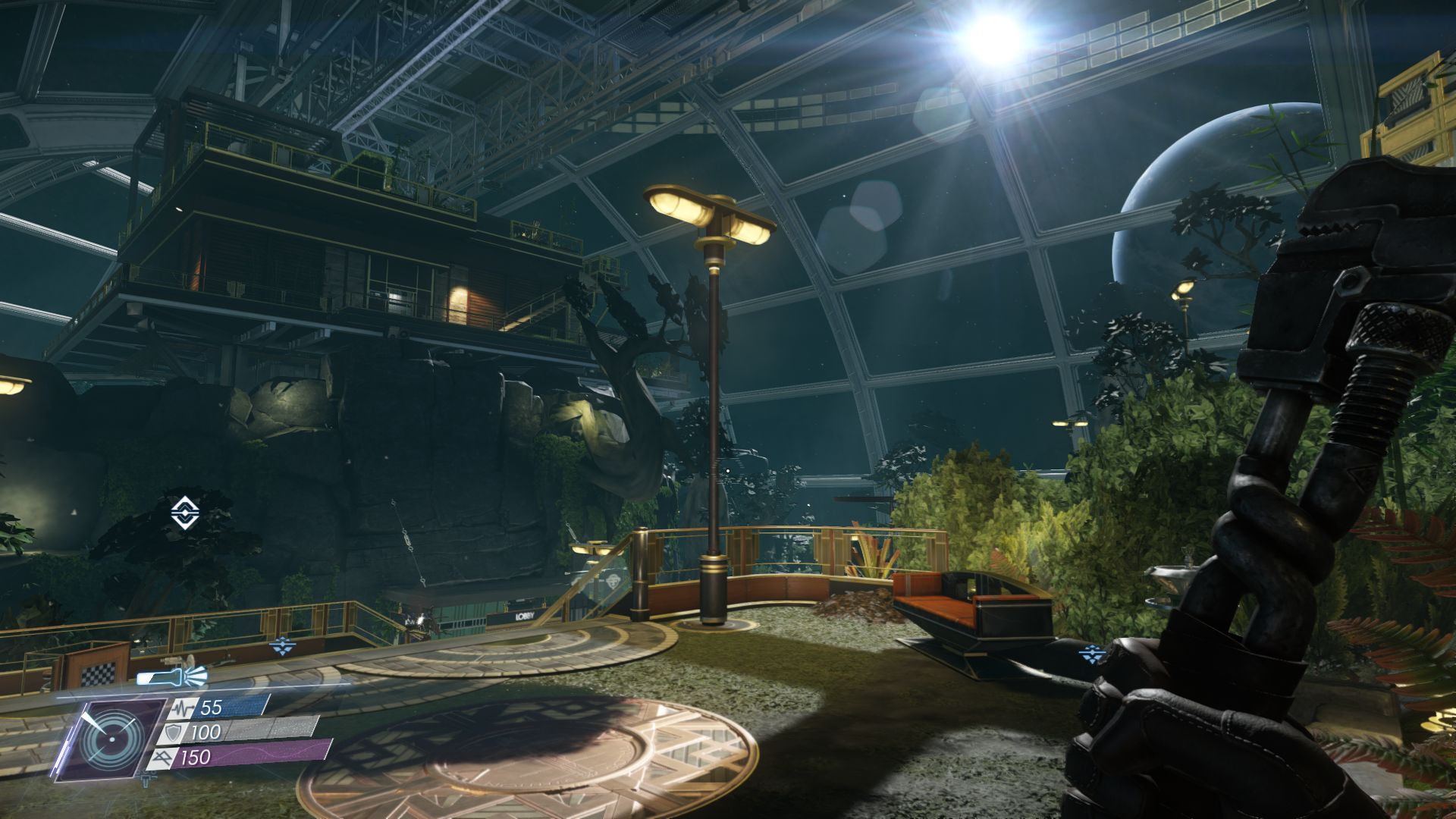
The Arboretum is a great area but not particularly attractive
Unlike the previous games by Arkane Studios, Prey uses the CryEngine to render its world. A bizarre choice considering the engine was built for expansive outdoor environments, not space station interiors. Apart from some flat lighting, the interiors look decent. Certain modules look great, like the Crew Quarters and Psychotronics labs. Even the Lobby is a showpiece for the moving sunlight shadows. It is ironic that the worst looking area happens to be the Arboretum biome; its 'natural' environment is boxy and belongs in a much older title. Fortunately the level structure usually makes up for visual shortcomings. As the game progresses, the bulkheads become infested with lingering yellow alien clouds that obscure hostiles and convey how bad things are getting. The Typhon Aliens look great, with their shimmering black skin and ink-like warping effects. Humans are practically caricatures and their low resolution face textures are slightly disappointing.
One of the best visual elements comes from the aptly named Looking Glass screens that consist of a flat surface that renders a 3D world behind it. Looking from a certain angle can reveal a password or a hidden trapdoor. Other screens, like one showing a fish tank, may hide a secret area behind their breakable surfaces. The tech is vastly underused given how impressive it is, but you can't have too much of a good thing. Prey is not an amazing looking game, but its visuals are acceptable given its numerous intelligent gameplay systems.
Less tolerable is the audio mixing and clarity. The music is too loud and sometimes not appropriate for the circumstances. While NPCs are rare, they were happy to talk over each other. Even the ambient sounds were a little broken; areas are split into sound zones, and merely stepping through a doorway might dramatically change the sound effects. The sound issues do not ruin the experience but they are distracting.
At least the performance is fine and the technical issues are minor. Framerate was consistent in all areas and during combat, only dropping noticeably in the Power Plant module. Load times between levels were fairly short too. Quests rarely broke but one major quest failed to progress until the exact same actions were repeated after reloading a save. As mentioned, the grid inventory is awesome but it's a shame that some items, like suit repair or specific foods, cannot be assigned to the hot key bar. It is also disappointing there are only 20 hard saves for such a lengthy game, but at least quick save functions well and the game has several autosaves for backups.
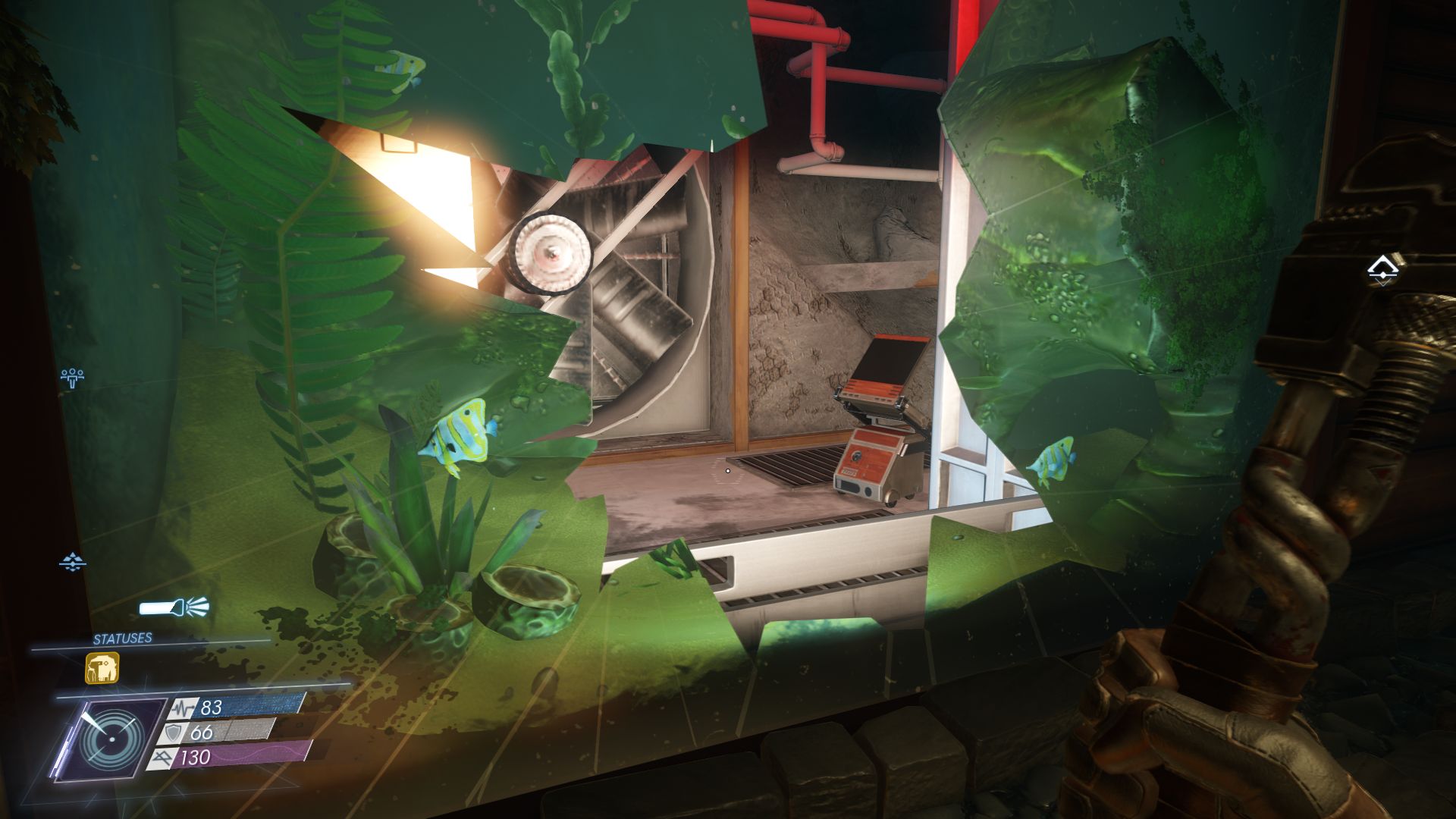
What's behind this Looking Glass screen? Probably another mimic
Prey should not be called Prey. Not just because it partly obfuscates the different and competent shooter from 2006, but mostly because it deserves to stand on its own as a fantastic and involving game. Fortunately it's just a name and Prey makes it clear that actions are more important. If you enjoyed BioShock or System Shock, then Prey is absolutely an essential purchase. It takes players into its sci-fi world and lets them interact in many different ways, from being a morally good stealthy player to a raging lunatic that equips alien skills and uses corpses to build an army. You can hack through terminals, climb on hand-placed foam globs, or just search for resources in the silence of open space. Exploring the detailed and large space station facilitates great independence and offers plenty of replay value. Prey may not be the best looking or sounding game, but its issues are largely washed away by the outstanding dynamic gameplay in an absorbing world. In years from now, we may confuse this Prey with that Prey, and that will mean I can return to Talos-1 as though I've suffered from a mild case of amnesia.
 Comments
Comments




















